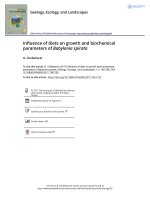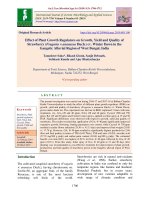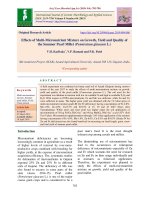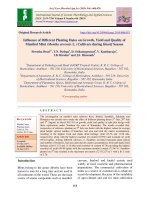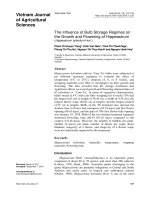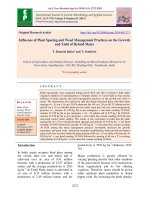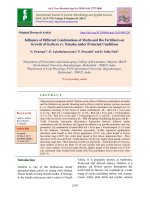Studies on the influence of growth regulators and chemicals on the quality parameters of grape cv. 2A clone
Bạn đang xem bản rút gọn của tài liệu. Xem và tải ngay bản đầy đủ của tài liệu tại đây (163.17 KB, 8 trang )
Int.J.Curr.Microbiol.App.Sci (2017) 6(5): 2585-2592
International Journal of Current Microbiology and Applied Sciences
ISSN: 2319-7706 Volume 6 Number 5 (2017) pp. 2585-2592
Journal homepage:
Original Research Article
/>
Studies on the Influence of Growth Regulators and Chemicals on the Quality
Parameters of Grape cv. 2A Clone
Shivaningapp Kumbar*, D.R. Patil, Kishore Kumar Das, G.S.K. Swamy,
N. Thammaiah, J. Jayappa and Kantesh Gandolkar
Department of Fruit Science, K.R.C. College of Horticulture, Arabhavi-591 218,
University of Horticultural Sciences, Bagalkot-587 102, Karnataka, India
*Corresponding author
ABSTRACT
Keywords
Grape,
Cycocel (CCC),
Maleic
hydrazide (MH),
Uracil, Quality
parameters
Article Info
Accepted:
25 April 2017
Available Online:
10 May 2017
An experiment was conducted at Main Horticultural Research and
Extension Centre (MHREC), Division of Fruit science, UHS, Bagalkot
(Karnataka) from May 2014 to March 2015 on four year old 2A Clone
grape vineyard to study the influence of growth regulators (i.e. retardants)
and chemicals on the quality parameters of grape cv. 2A Clone. The results
revealed that vines treated with CCC 750 ppm (T4) significantly showed an
increase in all the quality parameters of grape viz., total soluble solids
(22.01 °Brix), TSS to acid ratio (37.53), total sugars (21.50 %), reducing
sugar (19.60 %) and lowest acidity (0.59 %) as compared to other
treatments. The spray of 750 ppm cycocel (CCC) showed best result for
quality attributes of grape. Finally, it is concluded that applications of
growth retardants and chemicals are considered as a good viticulture
practice which could lead to the improvement in productivity and quality in
grapes.
Introduction
Grape (Vitis vinifera L.) is an important and
delicious subtropical fruit crop having its
origin in Asia Minor. In India it is cultivated
in an area of about 1.18 lakh ha with an
annual production of 25.85 lakh tonnes.
Grape cultivation in India acquires great
significance due to its high productivity (21.8
mt/ha) compared to many other grape
producing
countries
(Anon.,
2014).
Maharashtra occupies the largest area among
the different Indian states and Karnataka
stands second in grape production with a
productivity of (14.8 mt/ha). It produces 3.02
lakh tonnes annually from an area of 0.20
lakh ha (Anon., 2014). Among many cultivars
grown in India, Thompson Seedless is the
leading variety and recently 2A Clone is
gaining popularity in Karnataka and also in
other parts of India on account of its superior
table and raisin quality. Plant growth
retardants generally have great effects on
expanding of elongation cells, where
inhibition of GA synthesis rapidly causes
reduction in shoot elongation and thereby
2585
Int.J.Curr.Microbiol.App.Sci (2017) 6(5): 2585-2592
increase in fruit quality attributes (Tanimoto,
1983).
A lot of work on growth regulators i.e.
retardants and chemicals has been done singly
on several varieties of grapes, whereas
information on combined effect of growth
retardants and chemicals in grape, especially
2A Clone cultivar is scanty. Hence present
experiment was undertaken to find out the
influence of growth regulators and chemicals
on quality parameters in grape cv. 2A Clone.
Materials and Methods
A field experiment was conducted at Main
Horticultural Research and Extension Centre
(MHREC), Division of Fruit science, UHS,
Bagalkot (Karnataka) from May 2014 to
March 2015 on four year old 2A Clone grape
vineyard. Vines were planted at 3.0 m x 1.5 m
apart and trained on ‘Y’ system. The vines
were back pruned (vegetative/foundation
pruning) on 4th April, 2014 and for fruiting
(reproductive/forward
pruning)
was
performed on 10th October, 2014. Cultural
practices were uniform for all the vines,
irrespective of the treatments. Three growth
regulators (retardants) and chemicals viz.,
CCC (Cycocel), MH (Maleic hydrazide) and
Uracil were tried for their effect on quality
parameters along with control (without
spray). Fourteen treatments comprised of
growth regulators (retardants), chemicals and
their combinations along with control viz., T1
– Control i.e. without spray; T2 - CCC 250
ppm; T3 - CCC 500 ppm; T4 - CCC 750 ppm;
T5 - Uracil 50 ppm; T6 - Uracil 100 ppm; T7
- MH 500 ppm; T8 - CCC 250 ppm + Uracil
50 ppm; T9 - CCC 250 ppm + Uracil 100
ppm; T10 - CCC 500 ppm + Uracil 50 ppm;
T11- CCC 500 ppm + Uracil 100 ppm; T12 CCC 750 ppm + Uracil 50 ppm; T13 - CCC
750 ppm + Uracil 100 ppm and T14 - MH
500 ppm + Uracil 100 ppm. This investigation
was laid out in Randomized Block Design
(RBD) with three replications. The weather
parameters viz., maximum and minimum
temperature, relative humidity and average
rainfall in Bagalkot were recorded in
experimental location. The data was
statistically analysed interpreted here.
Preparation of growth regulators and
chemicals solution
In the present investigation, growth regulators
includes growth retardants namely cycocel
and maleic hydrazide. The formulations of all
the growth regulators and chemicals at
required concentrations were prepared by
dissolving appropriate amounts of growth
regulators and chemicals in small amount of
water and then the volume was made upto one
litre by adding water. First solution of higher
concentration was prepared and later solutions
of lower strength were prepared by diluting
with water. Proper mixing of the chemicals
was met with, to ensure uniform distribution
of chemicals all over the solution (Table 1).
Application of the growth regulators and
chemicals solution
The prepared growth regulators and chemical
solutions of different concentrations were
sprayed forty five days after foundation bud
pruning (Back pruning) i.e. 19th May, 2014 to
the vines with the help of sprayer during
evening hours as per the treatments.
Sampling of the bunches for recording
observations
Five bunches per vine were selected from the
tagged canes which were used to estimate the
quality parameters.
Total soluble solids (°Brix)
Total soluble solids (TSS) content was
recorded with the help of a hand refractometer
and expressed in degree Brix.
2586
Int.J.Curr.Microbiol.App.Sci (2017) 6(5): 2585-2592
Titratable acidity (%)
The acidity was determined in terms of
tartaric acid by diluting the juice extracted
from five gram of sample and filtered through
muslin cloth and made up to known volume
with distilled water (100 ml). From this, five
ml of aliquot was taken and titrated against
standard NaOH (0.1 N) using a
phenolphthalein as indicator. The appearance
of light pink colour was recorded as the end
point. The values were expressed in terms of
tartaric acid per cent titrable acidity of the
fruits (Ranganna, 1977).
was added to discolour the solution. Then
Dinitro-salicylic acid (DNSA) method for
estimation of reducing sugar was followed.
The results obtained were expressed in terms
of percentage.
Non-reducing sugars (%)
The percentage of non–reducing sugars was
determined by substracting the per cent
reducing sugar from the per cent total sugar
(Somogyi, 1952).
Non-reducing sugar (%) = Per cent total sugar
- Per cent reducing sugar
TSS to acid ratio
Results and Discussion
TSS to acid ratio was obtained by dividing
TSS (°Brix) with acidity (%) of
corresponding fruits.
Reducing sugar (%)
Reducing sugars in the berry preserved in 80
per cent alcohol was estimated as per the
Dinitro salicylic acid (DNSA) method
(Miller, 1972). A known volume of alcohol
extract was taken (need not go for
clarification in grapes) and allowed to
evaporate the alcohol completely. Clear
solution was taken for estimation of reducing
sugar using DNSA-reagent by following
above method, the values obtained were
expressed as percentage by referring to the
standard graph obtained with glucose.
Total sugars (%)
The total sugar in the sample was estimated
by same method as that of the reducing sugar
after inversion (Anon., 1984). One ml of
evaporated extract was taken and kept in
boiling water till the alcohol completely
evaporated and allowed it to cool. Then
phenolphthalein indicator was added followed
by 1N sodium hydroxide till the solution
turned to pink. Again 0.1N hydrochloric acid
The present investigation revealed that the
influence of growth regulators and chemicals
on the quality attributes. The results obtained
during the course of investigation are
presented in the present study.
In the present experiment, total soluble solids
(TSS) of berries among the various
treatments, the vines treated with CCC 750
ppm showed significantly highest TSS (22.01
°Brix) over other treatments by reducing the
acidity content. While control vines i.e
without spraying recorded total soluble solids
of 20.51 °Brix. The lowest was recorded in
vines treated with MH 500 ppm (18.99 °Brix)
which was on par with MH 500 ppm + uracil
100 ppm (19.13 °Brix) treatment (Table 2).
Similar results are in accordance with the
results obtained by Looney (1981), Patil
(1982) and Khajuria and Bakhshi (1984) also
indicated effective results with CCC in
improving the quality of grapes. The vines
treated with CCC 750 ppm recorded
significantly least percentage of acidity of
berries (0.59 %) due to high TSS content of
the berries as compared to other treatments.
While control vines i.e without spraying
recorded the acidity of (0.75 %) and was on
par with CCC 250 ppm + uracil 100 ppm
2587
Int.J.Curr.Microbiol.App.Sci (2017) 6(5): 2585-2592
(0.75 %) treatment. The highest acidity was
observed in vines treated with MH 500 ppm
(0.86 %) which was on par with MH 500 ppm
+ uracil 100 ppm (0.84 %) and uracil 50 ppm
(0.83 %) treatments (Table 2). The identical
results were reported by Bhat (1992) and
Sehrawat et al., (1998) in Thompson Seedless
grapes. Murthy (2014) also reported that
spraying of CCC with 1000 ppm at 21-25
days after April pruning increased the quality
in grapes. Among the various concentrations
of growth retardants and chemicals, the vines
treated with CCC 750 ppm improved the TSS
to titratable acid ratio by recording
significantly higher value (37.53) over other
treatments. This was followed by CCC 750
ppm + uracil 100 ppm (34.50) and CCC 750
ppm + uracil 50 ppm (32.50) concentrations.
The MH 500 ppm concentration declined the
ratio to the least (22.01) which was on par
with MH 500 ppm + uracil 100 ppm (22.68)
treatment (Table 2). Present findings are
substantiated with the findings of Abd ElRhman (2010) and Bhat (1992) in Thompson
Seedless grapes. The increased TSS to acid
ratio might be due to increase in total soluble
solids content and reduction in acid content of
the berries and which actually makes the
quality of grapes.
Table.1 Preparation of growth regulators and chemicals solution
S. No.
Growth regulators and
chemicals
Concentration
(ppm)
Quantity growth
regulators and
chemicals (mg)
Required
water (ml)
1.
Water
-
-
1000
2.
CCC
250
250
1000
3.
CCC
500
500
-do-
4.
CCC
750
750
-do-
5.
Uracil
50
50
-do-
6.
Uracil
100
100
-do-
7.
Maleic hydrazide
500
500
-do-
8.
CCC + Uracil
250 + 50
250 + 50
-do-
9.
CCC + Uracil
250 + 100
250 + 100
-do-
10.
CCC + Uracil
500 + 50
500 + 50
-do-
11.
CCC + Uracil
500 +100
500 + 100
-do-
12.
CCC + Uracil
750 + 50
750 + 50
-do-
13.
CCC + Uracil
750 + 100
750 + 100
-do-
14.
Maleic hydrazide + Uracil
500 + 100
500 + 100
-do-
2588
Int.J.Curr.Microbiol.App.Sci (2017) 6(5): 2585-2592
Table.2 Total soluble solids, acidity and TSS to acid ratio in grape cv. 2A Clone
(Vitis vinifera L.) as influenced by growth regulators and chemicals
Treatments
Total soluble solids (°Brix) Acidity (%) TSS to acid ratio
T1- Control (without spray)
20.51
0.75
27.48
T2 - CCC 250 ppm
19.93
0.81
24.73
T3 -CCC 500 ppm
20.69
0.73
28.34
T4- CCC 750 ppm
22.01
0.59
37.53
T5- Uracil 50 ppm
19.47
0.83
23.56
T6- Uracil 100 ppm
19.70
0.81
24.24
T7- MH 500 ppm
18.99
0.86
22.01
T8- CCC 250 ppm + Uracil 50 ppm
20.17
0.79
25.64
T9- CCC 250 ppm + Uracil 100 ppm
20.41
0.75
27.22
T10- CCC 500 ppm + Uracil 50 ppm
21.00
0.69
30.66
T11- CCC 500 ppm + Uracil 100 ppm
21.08
0.68
31.04
T12- CCC 750 ppm + Uracil 50 ppm
21.23
0.65
32.50
T13 CCC 750 ppm + Uracil 100 ppm
21.48
0.62
34.50
T14- MH 500 ppm + Uracil 100 ppm
19.13
0.84
22.68
SEm±
0.16
0.01
0.53
CD at 5%
0.47
0.03
1.54
CCC- Cycocel, MH- Maleic hydrazide
2589
Int.J.Curr.Microbiol.App.Sci (2017) 6(5): 2585-2592
Table.3 Total sugar, reducing sugar and non-reducing sugar content in grape cv. 2A Clone
(Vitis vinifera L.) as influenced by growth regulators and chemicals
Total sugar
Reducing sugar Non-reducing sugar
Treatments
(%)
(%)
(%)
T1- Control (without spray)
18.58
16.83
1.75
T2 - CCC 250 ppm
17.80
16.45
1.35
T3 -CCC 500 ppm
18.63
16.85
1.78
T4- CCC 750 ppm
21.50
19.60
1.90
T5- Uracil 50 ppm
17.62
16.30
1.32
T6- Uracil 100 ppm
17.20
15.99
1.22
T7- MH 500 ppm
16.98
15.70
1.28
T8- CCC 250 ppm + Uracil 50 ppm
17.83
16.58
1.25
T9- CCC 250 ppm + Uracil 100 ppm
18.35
16.79
1.56
T10- CCC 500 ppm + Uracil 50 ppm
18.50
16.95
1.55
T11- CCC 500 ppm + Uracil 100 ppm
18.90
17.43
1.47
T12- CCC 750 ppm + Uracil 50 ppm
20.05
18.35
1.70
T13 CCC 750 ppm + Uracil 100 ppm
20.53
18.70
1.83
T14- MH 500 ppm + Uracil 100 ppm
17.15
15.76
1.39
SEm±
0.22
0.09
0.16
CD at 5%
0.63
0.27
NS
CCC- Cycocel, MH- Maleic hydrazide, NS-Non-significant
2590
Int.J.Curr.Microbiol.App.Sci (2017) 6(5): 2585-2592
In the present study, the data on total sugar of
berries was significantly influenced by
various growth retardants and chemicals.
Among the various concentrations, the vines
treated with CCC 750 ppm recorded
significantly highest total sugars content in
berries (21.50 %) followed by CCC 750 ppm
+ uracil 100 ppm (20.53 %) and CCC 750
ppm + uracil 50 ppm (20.05 %) treatments.
The lowest was recorded in vines treated with
MH 500 ppm (16.98 %) which was on par
with MH 500 ppm + uracil 100 ppm (17.15
%) and uracil 100 ppm (17.20 %) treatments.
CCC 750 ppm treatment recorded highest
reducing sugar in berries (19.60 %) as
compared to other treatments. This was
followed by CCC 750 ppm + uracil 100 ppm
(18.70 %) and CCC 750 ppm + uracil 50 ppm
(18.35 %) treatments. The lowest was
recorded in vines treated with MH, 500 ppm
(15.70 %) which was on par with MH 500
ppm + uracil 100 ppm (15.76 %). The nonreducing sugar content was found to be nonsignificant (Table 3). These are in confirmed
with the results noted by Marchiori and Zanni
(1973) in Cabernet Franc vines. Ahlawat and
Daulta (1981) opined that cycocel at 500 and
1000 ppm improved berry set and quality of
Kishmish Charni grapes. This might be due to
high TSS and greater utilization and
assimilation of total carbohydrates during
flower bud initiation and differentiation in
cycocel treated vines.
In conclusion the Vines treated with CCC 750
ppm produces the good quality grapes for
attracting consumers and preparing good
quality raisins, along with higher yield than
the control vines (without spray). In both
table and raisin grapes along with higher
yield, quality characters are also more
important. From the present investigation, it is
concluded that, applications of growth
retardants and chemicals are considered as a
good viticulture practice which could lead to
the improvement in productivity and quality
in grapes.
References
Abd El-Rhman, I.E. 2010. A study on some
treatments which mitigate drought
effects on Barrani grapevines cv. J.
Appl. Sci. Res., 6(6): 704-711.
Ahlawat, V.P. and Daulta, B.S. 1981. Effect
of CCC and SADH on fruit set and
quality of Kishmish Charni grape (Vitis
vinifera L.). Haryana J. Hort. Sci., 10:
42-44.
Anonymous. 2014. Indian horticulture data
base, .
Anonymous. 1984. Official methods of
analysis,
Ed.
Sioney
Williams,
Association official analytical Virginia,
14th edition, pp: 423-462.
Bhat, V.R. 1992. Studies on back pruning,
growth retardants and pinching in some
cultivars of grape (Vitis vinifera L.).
Ph.D. thesis, University of Agricultural
Sciences, Dharwad.
Khajuria, H.N. and Bakhshi, J.C. 1984.
Responsiveness of perlette grapes (Vitis
vinifera L.) to the application of CCC,
NMC, TIBA, coconut milk and girdling
treatments. Indian Agric., 28: 255-260.
Looney, N.E. 1981. Some growth regulators
and cluster thinning effects on berry set
and size, berry quality, and annual
productivity of De Chaunac grapes.
Vitis, 20: 22-35.
Marchiori, G. and Zanni, L. 1973. Vegetative
and productive control in grapevines by
chemical (Cycocel) and mechanical
(ringing)
treatments.
Informatore
Agrario., 29(23): 12677-12679.
Miller, G.C. 1972. Use of dinitro salicylic
acid reagent for determination of
reducing sugar. Annual Chem.., 31:
426-428.
Murthy,
B.N.S.
2014.
Production
technologies recommended for tropical
fruit crops. ICAR-DAC Interface
Meeting, pp. 33-36.
2591
Int.J.Curr.Microbiol.App.Sci (2017) 6(5): 2585-2592
Patil, D.R. 1982. Studies on promotion of
fruitfulness in Thompson Seedless
grapevine (Vitis vinifera L.). M.Sc.
thesis, University of Agricultural
Sciences, Bangalore.
Ranganna, S. 1977. Manual of analysis of
fruit and vegetable products, Tata
McGraw- Hill publishing company
limited, New Delhi, India.
Sehrawat, S.K., Daulta, B.S., Dahiya, D.S.
and Bhardwaj, R. 1998. Effect of
growth retardants on growth, yield and
fruit quality in grape (Vitis vinifera L.)
cv. Thompson Seedless. Int. J. Trop.
Agric., 16(1/4): 179-184.
Somogyi, M.S. 1952. Notes on sugar
determination. J. Bio. Chem., 200: 24.
Tanimoto, E. 1983. Gibberellin-dependent not
elongation in Lactuca sativa: recovery
from growth retardant suppressed
elongation with thickening by low
concentration of GA3. Plant Cell
Physiol., 28: 963-973.
How to cite this article:
Shivaningapp Kumbar, D. R. Patil, Kishore Kumar Das, G. S. K. Swamy, N. Thammaiah, J.
Jayappa and Kantesh Gandolkar. 2017. Studies on the Influence of Growth Regulators and
Chemicals on the Quality Parameters of Grape cv. 2A Clone. Int.J.Curr.Microbiol.App.Sci. 6(5):
2585-2592. doi: />
2592
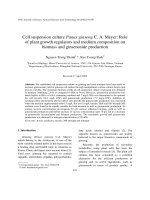

![pike - 2003 - studies on audit quality [aq]](https://media.store123doc.com/images/document/2015_01/06/medium_skm1420548229.jpg)
